

Rainforest Biomes. The tropical rain forest is a forest of tall trees in a region of year-round warmth.
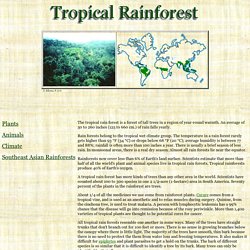
An average of 50 to 260 inches (125 to 660 cm.) of rain falls yearly. Rain forests belong to the tropical wet climate group. The temperature in a rain forest rarely gets higher than 93 °F (34 °C) or drops below 68 °F (20 °C); average humidity is between 77 and 88%; rainfall is often more than 100 inches a year. There is usually a brief season of less rain. In monsoonal areas, there is a real dry season. Rainforests now cover less than 6% of Earth's land surface. Flora Fauna Web - Home. Tropical Rain Forest: an Endangered Species Spotlight Topic. Tropical rain forests once blanketed the Earth like a wide green belt around the equator.
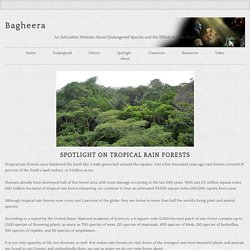
Just a few thousand years ago rain forests covered 14 percent of the Earth’s land surface, or 5 billion acres. Humans already have destroyed half of this forest area, with most damage occurring in the last 200 years. With just 2.5 million square miles (647 million hectares) of tropical rain forest remaining, we continue to lose an estimated 93,000 square miles (150,000 square km) a year.
Although tropical rain forests now cover just 2 percent of the globe, they are home to more than half the world’s living plant and animal species. According to a report by the United States’ National Academy of Sciences, a 4-square-mile (1,000 hectare) patch of rain forest contains up to 1,500 species of flowering plants, as many as 750 species of trees, 125 species of mammals, 400 species of birds, 150 species of butterflies, 100 species of reptiles, and 60 species of amphibians.
The Plants of the Rainforest. A tropical greenhouse More than two thirds of the world's plant species are found in the tropical rainforests: plants that provide shelter and food for rainforest animals as well as taking part in the gas exchanges which provide much of the world's oxygen supply.
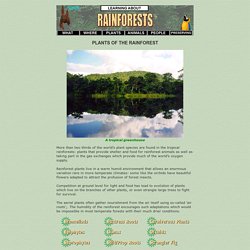
Rainforest plants live in a warm humid environment that allows an enormous variation rare in more temperate climates: some like the orchids have beautiful flowers adapted to attract the profusion of forest insects. Competition at ground level for light and food has lead to evolution of plants which live on the branches of other plants, or even strangle large trees to fight for survival. The aerial plants often gather nourishment from the air itself using so-called 'air roots';.
The humidity of the rainforest encourages such adaptations which would be impossible in most temperate forests with their much drier conditions. Flora Fauna Web - Flora Glossary. Tropical Rainforest Plants. Plants. If you're not a microbe and you're not an animal, you are probably a plant.
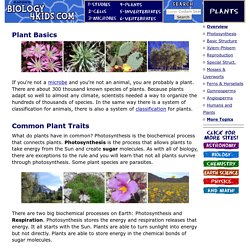
There are about 300 thousand known species of plants. Because plants adapt so well to almost any climate, scientists needed a way to organize the hundreds of thousands of species. In the same way there is a system of classification for animals, there is also a system of classification for plants. What do plants have in common?
Photosynthesis is the biochemical process that connects plants. There are two big biochemical processes on Earth: Photosynthesis and Respiration. Plants also have cell walls that are made of cellulose. Not only do you see plants everywhere in the real world, but they are also all over the scientific world. On a non-scientific level, farmers have been observing plants for thousands of years. National Botanic Garden (US Capitol Video) The Canopy 1a. Flora - Save the Amazon Rainforest. The Amazon rainforest has a huge live collection of flora species.
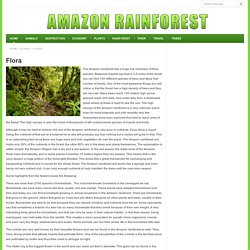
Botanical experts say that in 2.5 acres of the forest you can find 700 different species of trees and twice that number of plants. One of the most awesome things you will notice is that the forest has a high density of trees and they are very tall. Many trees reach 130 meters high (some species reach 200 feet), and under they form a shadowed place where at times is hard to see the sun. Ten Amazing Rainforest Plants. Our surroundings are sometimes taken for granted.

Even something as unique as the rainforest is forgotten. It seems a little bit of knowledge and a shove in the right direction can get people to appreciate the environment. So, why not start with the wonder that is the rainforest? Even though rainforests only cover less than two percent of the Earth’s entire surface area, they are home to 50 percent of the plants and animals. They are also found on every continent, except Antarctica. You’re probably thinking “I know all there is to know about bananas; I eat them for breakfast and can make delicious banana bread.”
Habitation: Found in Central America, South America, Africa, Southeast Asia and non-tropical regions like the United States thanks to modern agricultural technologies. Known for their beauty, orchids are the largest family of plants in the world. What would you do if you couldn’t have that cup of coffee in the morning? Want some more amazing rainforest galleries?